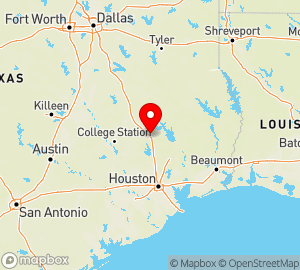Walker County, Texas

PO Box 1207
Huntsville, TX 77342
Phone: (936) 436-4933
Fax: (936) 436-4930
www.co.walker.tx.us
In east-central TX, northwest of Houston; organized Apr 6, 1846 from Montgomery County. Name Origin: Either for Robert James Walker (1801-69), U.S. senator who introduced the resolution to annex TX to the U.S., or for Samuel Hamilton Walker (1809-47), a Mexican War casualty
Area (sq mi):: 801.44 (land 787.45; water 13.99) Population per square mile: 79.70
Population 2005: 62,735 State rank: 52 Population change: 2000-20005 1.60%; 1990-2000 21.30% Population 2000: 61,758 (White 60.10%; Black or African American 23.90%; Hispanic or Latino 14.10%; Asian 0.80%; Other 6.30%). Foreign born: 4.50%. Median age: 31.00
Income 2000: per capita $14,508; median household $31,468; Population below poverty level: 18.40% Personal per capita income (2000-2003): $16,982-$17,839
Unemployment (2004): 5.70% Unemployment change (from 2000): 3.00% Median travel time to work: 22.70 minutes Working outside county of residence: 22.20%
Cities with population over 10,000:Huntsville, TX 77342
Phone: (936) 436-4933
Fax: (936) 436-4930
www.co.walker.tx.us
In east-central TX, northwest of Houston; organized Apr 6, 1846 from Montgomery County. Name Origin: Either for Robert James Walker (1801-69), U.S. senator who introduced the resolution to annex TX to the U.S., or for Samuel Hamilton Walker (1809-47), a Mexican War casualty
Area (sq mi):: 801.44 (land 787.45; water 13.99) Population per square mile: 79.70
Population 2005: 62,735 State rank: 52 Population change: 2000-20005 1.60%; 1990-2000 21.30% Population 2000: 61,758 (White 60.10%; Black or African American 23.90%; Hispanic or Latino 14.10%; Asian 0.80%; Other 6.30%). Foreign born: 4.50%. Median age: 31.00
Income 2000: per capita $14,508; median household $31,468; Population below poverty level: 18.40% Personal per capita income (2000-2003): $16,982-$17,839
Unemployment (2004): 5.70% Unemployment change (from 2000): 3.00% Median travel time to work: 22.70 minutes Working outside county of residence: 22.20%
 (35,840) (35,840) |
See other counties in Texas.
Walker County, Alabama
PO Box 1447
Jasper, AL 35502
Phone: (205) 384-7230
Fax: (205) 384-7003
www.walkercounty.com
In west-central AL, northwest of Birmingham; organized Dec 20, 1823 from Marion and Tuscaloosa counties. Name Origin: For John Williams Walker (1783-1823), U.S. senator from AL (1819-22)
Area (sq mi):: 805.30 (land 794.39; water 10.91) Population per square mile: 88.30
Population 2005: 70,117 State rank: 20 Population change: 2000-20005 -0.80%; 1990-2000 4.50% Population 2000: 70,713 (White 91.70%; Black or African American 6.20%; Hispanic or Latino 0.90%; Asian 0.20%; Other 1.50%). Foreign born: 0.70%. Median age: 38.30
Income 2000: per capita $15,546; median household $29,076; Population below poverty level: 16.50% Personal per capita income (2000-2003): $20,711-$23,449
Unemployment (2004): 6.10% Unemployment change (from 2000): -1.30% Median travel time to work: 33.20 minutes Working outside county of residence: 37.00%
Cities with population over 10,000:Jasper, AL 35502
Phone: (205) 384-7230
Fax: (205) 384-7003
www.walkercounty.com
In west-central AL, northwest of Birmingham; organized Dec 20, 1823 from Marion and Tuscaloosa counties. Name Origin: For John Williams Walker (1783-1823), U.S. senator from AL (1819-22)
Area (sq mi):: 805.30 (land 794.39; water 10.91) Population per square mile: 88.30
Population 2005: 70,117 State rank: 20 Population change: 2000-20005 -0.80%; 1990-2000 4.50% Population 2000: 70,713 (White 91.70%; Black or African American 6.20%; Hispanic or Latino 0.90%; Asian 0.20%; Other 1.50%). Foreign born: 0.70%. Median age: 38.30
Income 2000: per capita $15,546; median household $29,076; Population below poverty level: 16.50% Personal per capita income (2000-2003): $20,711-$23,449
Unemployment (2004): 6.10% Unemployment change (from 2000): -1.30% Median travel time to work: 33.20 minutes Working outside county of residence: 37.00%
 (13,907) (13,907) |
See other counties in Alabama.
Walker County, Georgia
PO Box 445
La Fayette, GA 30728
Phone: (706) 638-1437
Fax: (706) 638-1453
www.co.walker.ga.us
On the northern border of GA, south of Chattanooga, TN; organized Dec 18, 1833 from Murray County. Name Origin: For Maj. Freeman Walker (1780-1827), GA legislator, U.S. senator (1819-21), and mayor of Augusta (1818-19; 1823)
Area (sq mi):: 447.03 (land 446.58; water 0.45) Population per square mile: 143.10
Population 2005: 63,890 State rank: 31 Population change: 2000-20005 4.60%; 1990-2000 4.70% Population 2000: 61,053 (White 93.90%; Black or African American 3.80%; Hispanic or Latino 0.90%; Asian 0.30%; Other 1.50%). Foreign born: 1.00%. Median age: 37.10
Income 2000: per capita $15,867; median household $32,406; Population below poverty level: 12.50% Personal per capita income (2000-2003): $21,833-$22,286
Unemployment (2004): 4.20% Unemployment change (from 2000): 0.30% Median travel time to work: 26.50 minutes Working outside county of residence: 58.70%
Cities with population over 10,000: None La Fayette, GA 30728
Phone: (706) 638-1437
Fax: (706) 638-1453
www.co.walker.ga.us
On the northern border of GA, south of Chattanooga, TN; organized Dec 18, 1833 from Murray County. Name Origin: For Maj. Freeman Walker (1780-1827), GA legislator, U.S. senator (1819-21), and mayor of Augusta (1818-19; 1823)
Area (sq mi):: 447.03 (land 446.58; water 0.45) Population per square mile: 143.10
Population 2005: 63,890 State rank: 31 Population change: 2000-20005 4.60%; 1990-2000 4.70% Population 2000: 61,053 (White 93.90%; Black or African American 3.80%; Hispanic or Latino 0.90%; Asian 0.30%; Other 1.50%). Foreign born: 1.00%. Median age: 37.10
Income 2000: per capita $15,867; median household $32,406; Population below poverty level: 12.50% Personal per capita income (2000-2003): $21,833-$22,286
Unemployment (2004): 4.20% Unemployment change (from 2000): 0.30% Median travel time to work: 26.50 minutes Working outside county of residence: 58.70%
See other counties in Georgia.
Counties USA: A Directory of United States Counties, 3rd Edition. © 2006 by Omnigraphics, Inc.